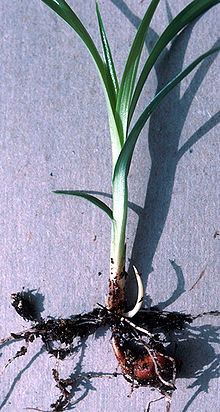- Cyperus esculentus
-
Cyperus esculentus 
Scientific classification Kingdom: Plantae (unranked): Angiosperms (unranked): Monocots (unranked): Commelinids Order: Poales Family: Cyperaceae Genus: Cyperus Species: C. esculentus Binomial name Cyperus esculentus
L.Cyperus esculentus (chufa sedge, yellow nutsedge, tigernut sedge, earth almond) is a species of sedge native to warm temperate to subtropical regions of the Northern Hemisphere, often cultivated for its edible tubers (tigernuts). It is an annual or perennial plant, growing to 90 cm tall, with solitary stems growing from a tuber. The stems are triangular in section, and bear slender leaves 3–10 mm wide. The flowers of the plant are distinctive, with a cluster of flat oval seeds surrounded by four hanging, leaf-like bracts positioned 90 degrees from each other. The plant foliage is very tough and fibrous, and is often mistaken for a grass.
There are several varieties:
- Cyperus esculentus var. esculentus - Mediterranean region east to India
- Cyperus esculentus var. hermannii - Florida
- Cyperus esculentus var. leptostachyus - United States
- Cyperus esculentus var. macrostachyus - United States
- Cyperus esculentus var. sativus - Asia, cultivated origin
Contents
Cultivation and uses
History
Zohary and Hopf consider this tuber "ranks among the oldest cultivated plants in Ancient Egypt." Although noting "Chufa was no doubt an important food element in ancient Egypt during dynastic times, its cultivation in ancient times seems to have remained (totally or almost totally) an Egyptian specialty."[1] They were used to make cakes in ancient Egypt. Presently, they are cultivated mainly, at least for extended and common commercial purposes, in Spain, where they were introduced by Arabs, almost exclusively in the Valencia region. They are found extensively in California and were grown by the Paiute in Owens Valley.
Tiger nuts are also grown in Ghana, Nigeria, Burkina Faso and Mali.
Use as food
The tubers are edible, with a slightly sweet, nutty flavour, compared to the more bitter-tasting tuber of the related Cyperus rotundus (purple nutsedge). They are quite hard, and are generally soaked in water before they can be eaten, thus making them much softer and giving them a better texture. They have various uses; in particular, they are used in Spain to make horchata. They are sometimes known by their Spanish name, chufa.
Tigernuts have excellent nutritional qualities, with a fat composition similar to olives and a rich mineral content, especially phosphorus and potassium. The oil of the tuber was found to contain 18% saturated (palmitic acid and stearic acid) and 82% unsaturated (oleic acid and linoleic acid) fatty acids.[2]
According to the Consejo Regulador de Chufa de Valencia (Regulating Council for Valencia's Tigernuts),[3] the nutritional composition/100 ml of a classical horchata de chufas, or orxata de xufes in Valencian language, is as follows: energy content around 66 kcal, proteins around 0.5 g, carbohydrates over 10 g with starch at least 1.9 g, fats at least 2 g. It can be useful in replacing milk in the diet of people intolerant to lactose to a certain extent.
Use as oil
Since the tubers contain 20-36% oil, C. esculentus has been suggested as potential oil crop for the production of biodiesel.[2]
Use as fishing bait
The boiled nuts are used in the UK as a bait for carp, and have a reputation for success. The nuts have to be prepared in a prescribed manner to prevent harm to the fish. The nuts are soaked in water for 24 hours and then boiled for 20 minutes or longer until fully expanded. Some anglers then leave the boiled nuts to ferment for 24–48 hours, which can enhance their effectiveness. If the nuts are not properly prepared, however, they can be extremely toxic to the carp. This was originally thought to have been the cause of death of Benson, a very large and very famous carp. The 54-lb. fish was found floating dead in a fishing lake, with a bag of unprepared tiger nuts lying nearby, empty, on the shore. An examination of the fish by a taxidermist concluded tiger nut poisoning was not, in the end, the cause of death.[4]
Use in pharmacy
As a source of oils, the tubers were used in pharmacy under the Latin name bulbuli thrasi beginning no later than the end of 18th century.[5]
Removal
The plant is extremely difficult to remove completely from lawns and gardens, where it is considered an intrusive weed. This is due to the plant having a stratified and layered root system, with tubers and roots being interconnected to a depth of 50 cm or more[citation needed]. The tubers are connected by fragile roots that are prone to snapping when pulled, making the root system difficult to remove intact. The plant can quickly regenerate if a single tuber is left in place.
Notes
- ^ Daniel Zohary and Maria Hopf, Domestication of plants in the Old World, third edition (Oxford: University Press, 2000), p. 198
- ^ a b Zhang et al Yellow nut-sedge tuber oil as a fuel
- ^ Consejo Regulador de Chufa de Valencia
- ^ http://online.wsj.com/article/SB125051804649836945.html
- ^ Pharmacopoea Batava. Ed. J. F. Niemann, Mediolani 1824
External links
Categories:- Flora of Canada
- Edible nuts and seeds
- Cyperus
- Valencian Community
- Lawn weeds
- Root vegetables
Wikimedia Foundation. 2010.

